Analyzing News Articles: Indigenous Health and Public Perception
VerifiedAdded on 2023/06/03
|9
|2285
|382
Report
AI Summary
This report analyzes five news articles concerning Indigenous health in Australia, focusing on how the articles shape public opinion and understanding of key issues. The report examines the angles, pitches, and framing techniques used in each article, including those related to housing, suicide rates, dental health, government funding, and healthcare access. The analysis reveals the media's agenda in each case, the target audiences, and the overall impact on the perception of Indigenous health challenges. The articles highlight inequalities in health outcomes, the impact of funding cuts, and the importance of addressing mental health and dental care. The report concludes that Indigenous health remains a significant concern, with media strategies varying to influence stakeholders and the public. This report is available on Desklib, a platform offering past papers and solved assignments for students.
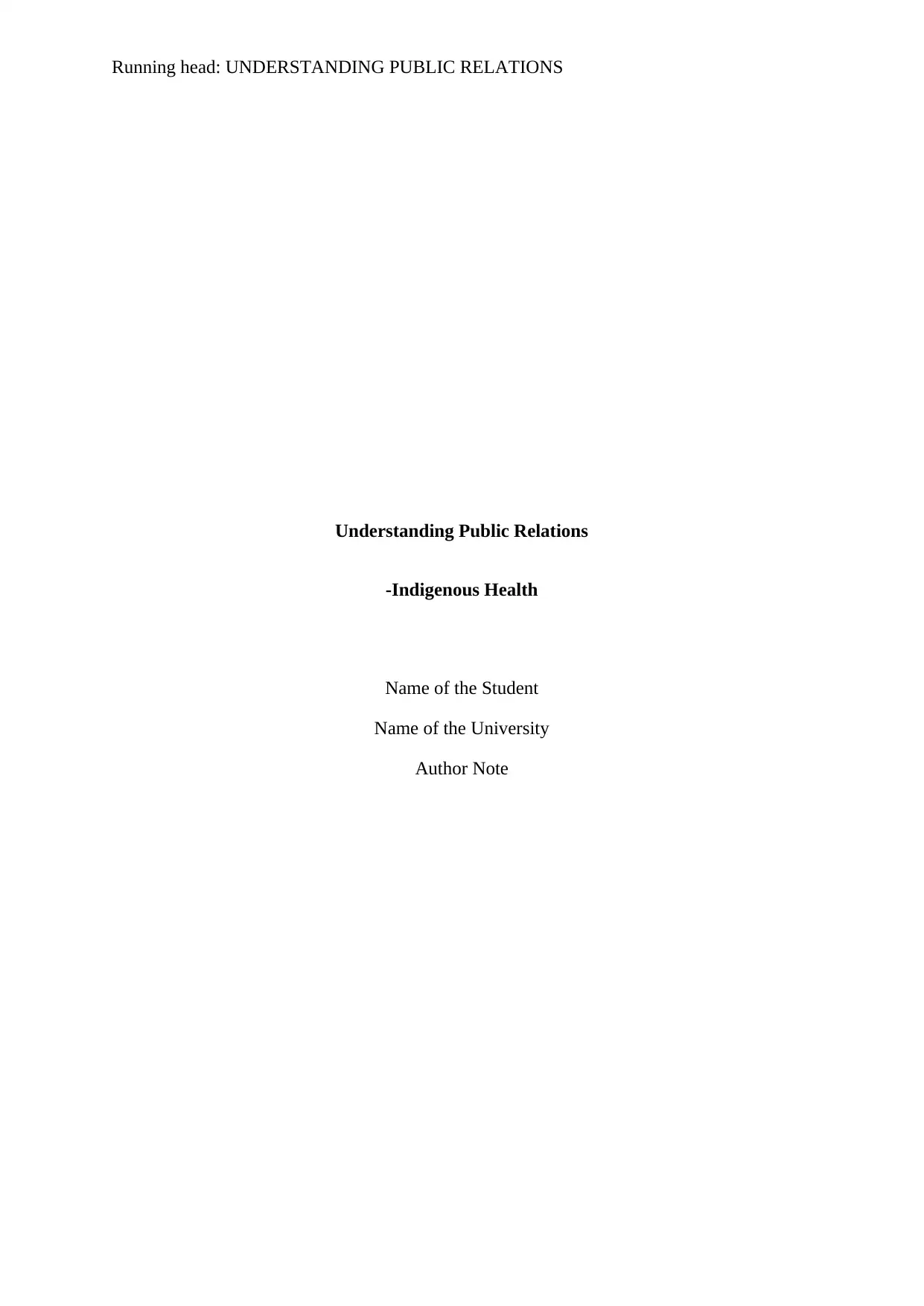
Running head: UNDERSTANDING PUBLIC RELATIONS
Understanding Public Relations
-Indigenous Health
Name of the Student
Name of the University
Author Note
Understanding Public Relations
-Indigenous Health
Name of the Student
Name of the University
Author Note
Paraphrase This Document
Need a fresh take? Get an instant paraphrase of this document with our AI Paraphraser
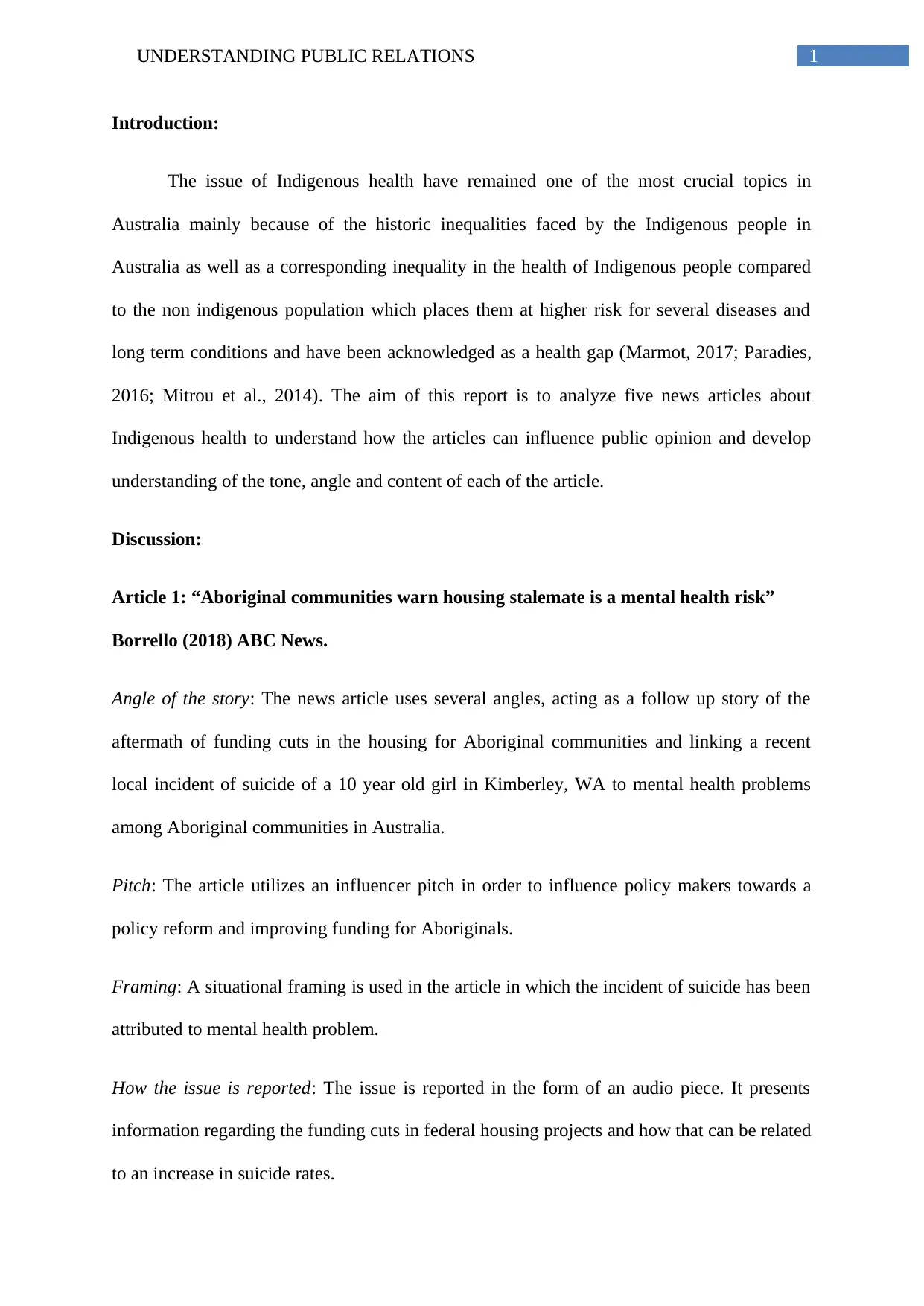
1UNDERSTANDING PUBLIC RELATIONS
Introduction:
The issue of Indigenous health have remained one of the most crucial topics in
Australia mainly because of the historic inequalities faced by the Indigenous people in
Australia as well as a corresponding inequality in the health of Indigenous people compared
to the non indigenous population which places them at higher risk for several diseases and
long term conditions and have been acknowledged as a health gap (Marmot, 2017; Paradies,
2016; Mitrou et al., 2014). The aim of this report is to analyze five news articles about
Indigenous health to understand how the articles can influence public opinion and develop
understanding of the tone, angle and content of each of the article.
Discussion:
Article 1: “Aboriginal communities warn housing stalemate is a mental health risk”
Borrello (2018) ABC News.
Angle of the story: The news article uses several angles, acting as a follow up story of the
aftermath of funding cuts in the housing for Aboriginal communities and linking a recent
local incident of suicide of a 10 year old girl in Kimberley, WA to mental health problems
among Aboriginal communities in Australia.
Pitch: The article utilizes an influencer pitch in order to influence policy makers towards a
policy reform and improving funding for Aboriginals.
Framing: A situational framing is used in the article in which the incident of suicide has been
attributed to mental health problem.
How the issue is reported: The issue is reported in the form of an audio piece. It presents
information regarding the funding cuts in federal housing projects and how that can be related
to an increase in suicide rates.
Introduction:
The issue of Indigenous health have remained one of the most crucial topics in
Australia mainly because of the historic inequalities faced by the Indigenous people in
Australia as well as a corresponding inequality in the health of Indigenous people compared
to the non indigenous population which places them at higher risk for several diseases and
long term conditions and have been acknowledged as a health gap (Marmot, 2017; Paradies,
2016; Mitrou et al., 2014). The aim of this report is to analyze five news articles about
Indigenous health to understand how the articles can influence public opinion and develop
understanding of the tone, angle and content of each of the article.
Discussion:
Article 1: “Aboriginal communities warn housing stalemate is a mental health risk”
Borrello (2018) ABC News.
Angle of the story: The news article uses several angles, acting as a follow up story of the
aftermath of funding cuts in the housing for Aboriginal communities and linking a recent
local incident of suicide of a 10 year old girl in Kimberley, WA to mental health problems
among Aboriginal communities in Australia.
Pitch: The article utilizes an influencer pitch in order to influence policy makers towards a
policy reform and improving funding for Aboriginals.
Framing: A situational framing is used in the article in which the incident of suicide has been
attributed to mental health problem.
How the issue is reported: The issue is reported in the form of an audio piece. It presents
information regarding the funding cuts in federal housing projects and how that can be related
to an increase in suicide rates.
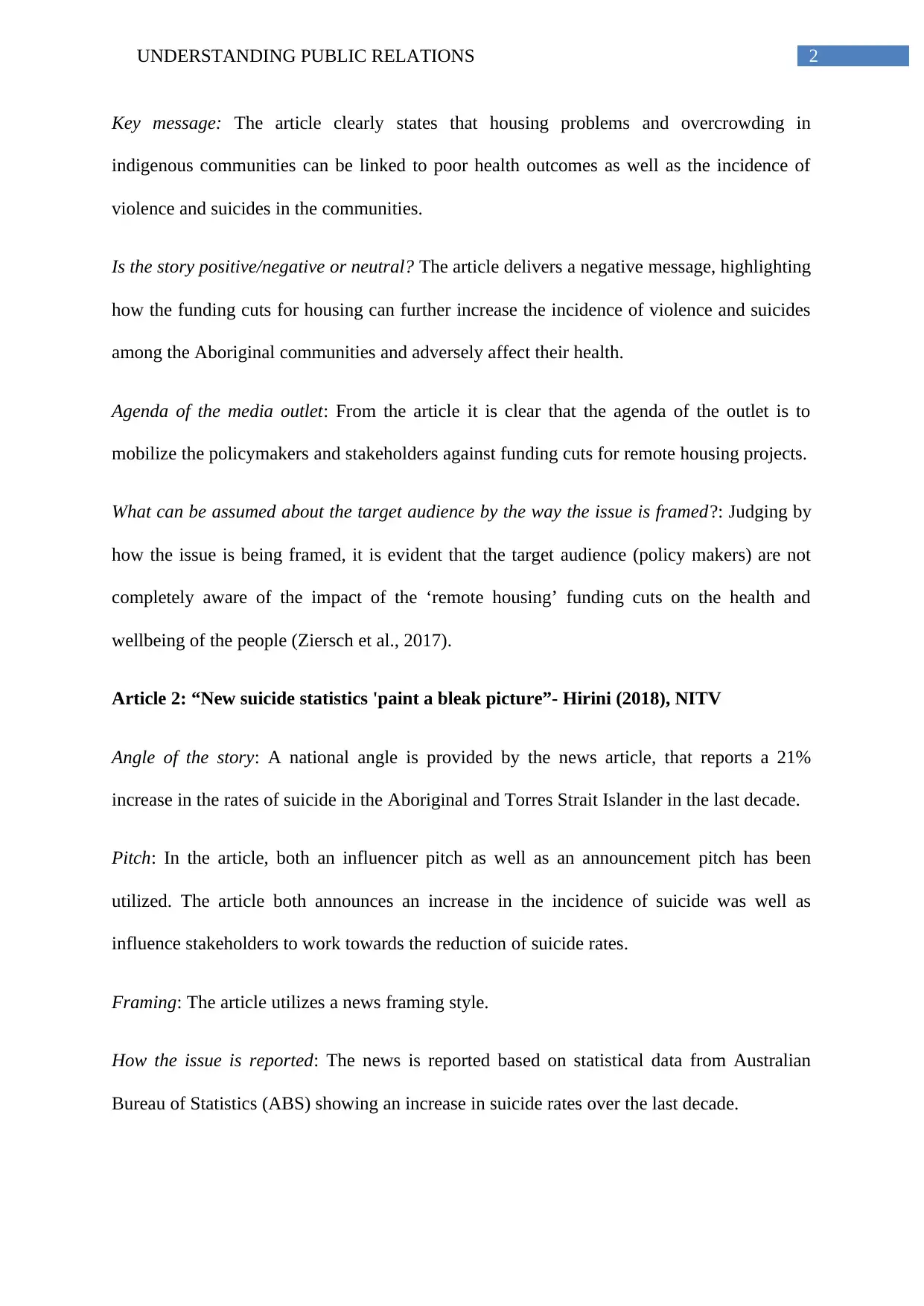
2UNDERSTANDING PUBLIC RELATIONS
Key message: The article clearly states that housing problems and overcrowding in
indigenous communities can be linked to poor health outcomes as well as the incidence of
violence and suicides in the communities.
Is the story positive/negative or neutral? The article delivers a negative message, highlighting
how the funding cuts for housing can further increase the incidence of violence and suicides
among the Aboriginal communities and adversely affect their health.
Agenda of the media outlet: From the article it is clear that the agenda of the outlet is to
mobilize the policymakers and stakeholders against funding cuts for remote housing projects.
What can be assumed about the target audience by the way the issue is framed?: Judging by
how the issue is being framed, it is evident that the target audience (policy makers) are not
completely aware of the impact of the ‘remote housing’ funding cuts on the health and
wellbeing of the people (Ziersch et al., 2017).
Article 2: “New suicide statistics 'paint a bleak picture”- Hirini (2018), NITV
Angle of the story: A national angle is provided by the news article, that reports a 21%
increase in the rates of suicide in the Aboriginal and Torres Strait Islander in the last decade.
Pitch: In the article, both an influencer pitch as well as an announcement pitch has been
utilized. The article both announces an increase in the incidence of suicide was well as
influence stakeholders to work towards the reduction of suicide rates.
Framing: The article utilizes a news framing style.
How the issue is reported: The news is reported based on statistical data from Australian
Bureau of Statistics (ABS) showing an increase in suicide rates over the last decade.
Key message: The article clearly states that housing problems and overcrowding in
indigenous communities can be linked to poor health outcomes as well as the incidence of
violence and suicides in the communities.
Is the story positive/negative or neutral? The article delivers a negative message, highlighting
how the funding cuts for housing can further increase the incidence of violence and suicides
among the Aboriginal communities and adversely affect their health.
Agenda of the media outlet: From the article it is clear that the agenda of the outlet is to
mobilize the policymakers and stakeholders against funding cuts for remote housing projects.
What can be assumed about the target audience by the way the issue is framed?: Judging by
how the issue is being framed, it is evident that the target audience (policy makers) are not
completely aware of the impact of the ‘remote housing’ funding cuts on the health and
wellbeing of the people (Ziersch et al., 2017).
Article 2: “New suicide statistics 'paint a bleak picture”- Hirini (2018), NITV
Angle of the story: A national angle is provided by the news article, that reports a 21%
increase in the rates of suicide in the Aboriginal and Torres Strait Islander in the last decade.
Pitch: In the article, both an influencer pitch as well as an announcement pitch has been
utilized. The article both announces an increase in the incidence of suicide was well as
influence stakeholders to work towards the reduction of suicide rates.
Framing: The article utilizes a news framing style.
How the issue is reported: The news is reported based on statistical data from Australian
Bureau of Statistics (ABS) showing an increase in suicide rates over the last decade.
⊘ This is a preview!⊘
Do you want full access?
Subscribe today to unlock all pages.

Trusted by 1+ million students worldwide
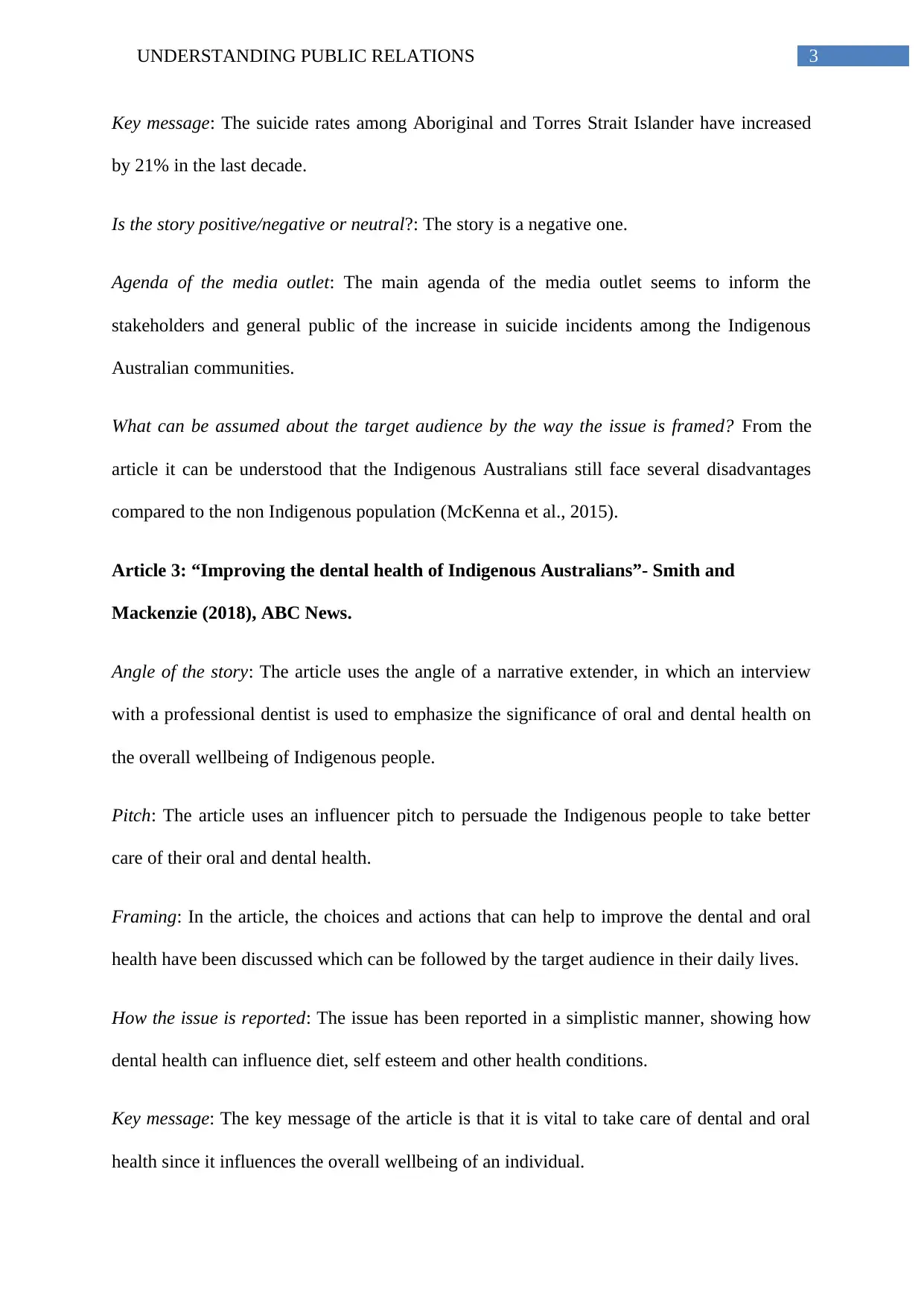
3UNDERSTANDING PUBLIC RELATIONS
Key message: The suicide rates among Aboriginal and Torres Strait Islander have increased
by 21% in the last decade.
Is the story positive/negative or neutral?: The story is a negative one.
Agenda of the media outlet: The main agenda of the media outlet seems to inform the
stakeholders and general public of the increase in suicide incidents among the Indigenous
Australian communities.
What can be assumed about the target audience by the way the issue is framed? From the
article it can be understood that the Indigenous Australians still face several disadvantages
compared to the non Indigenous population (McKenna et al., 2015).
Article 3: “Improving the dental health of Indigenous Australians”- Smith and
Mackenzie (2018), ABC News.
Angle of the story: The article uses the angle of a narrative extender, in which an interview
with a professional dentist is used to emphasize the significance of oral and dental health on
the overall wellbeing of Indigenous people.
Pitch: The article uses an influencer pitch to persuade the Indigenous people to take better
care of their oral and dental health.
Framing: In the article, the choices and actions that can help to improve the dental and oral
health have been discussed which can be followed by the target audience in their daily lives.
How the issue is reported: The issue has been reported in a simplistic manner, showing how
dental health can influence diet, self esteem and other health conditions.
Key message: The key message of the article is that it is vital to take care of dental and oral
health since it influences the overall wellbeing of an individual.
Key message: The suicide rates among Aboriginal and Torres Strait Islander have increased
by 21% in the last decade.
Is the story positive/negative or neutral?: The story is a negative one.
Agenda of the media outlet: The main agenda of the media outlet seems to inform the
stakeholders and general public of the increase in suicide incidents among the Indigenous
Australian communities.
What can be assumed about the target audience by the way the issue is framed? From the
article it can be understood that the Indigenous Australians still face several disadvantages
compared to the non Indigenous population (McKenna et al., 2015).
Article 3: “Improving the dental health of Indigenous Australians”- Smith and
Mackenzie (2018), ABC News.
Angle of the story: The article uses the angle of a narrative extender, in which an interview
with a professional dentist is used to emphasize the significance of oral and dental health on
the overall wellbeing of Indigenous people.
Pitch: The article uses an influencer pitch to persuade the Indigenous people to take better
care of their oral and dental health.
Framing: In the article, the choices and actions that can help to improve the dental and oral
health have been discussed which can be followed by the target audience in their daily lives.
How the issue is reported: The issue has been reported in a simplistic manner, showing how
dental health can influence diet, self esteem and other health conditions.
Key message: The key message of the article is that it is vital to take care of dental and oral
health since it influences the overall wellbeing of an individual.
Paraphrase This Document
Need a fresh take? Get an instant paraphrase of this document with our AI Paraphraser
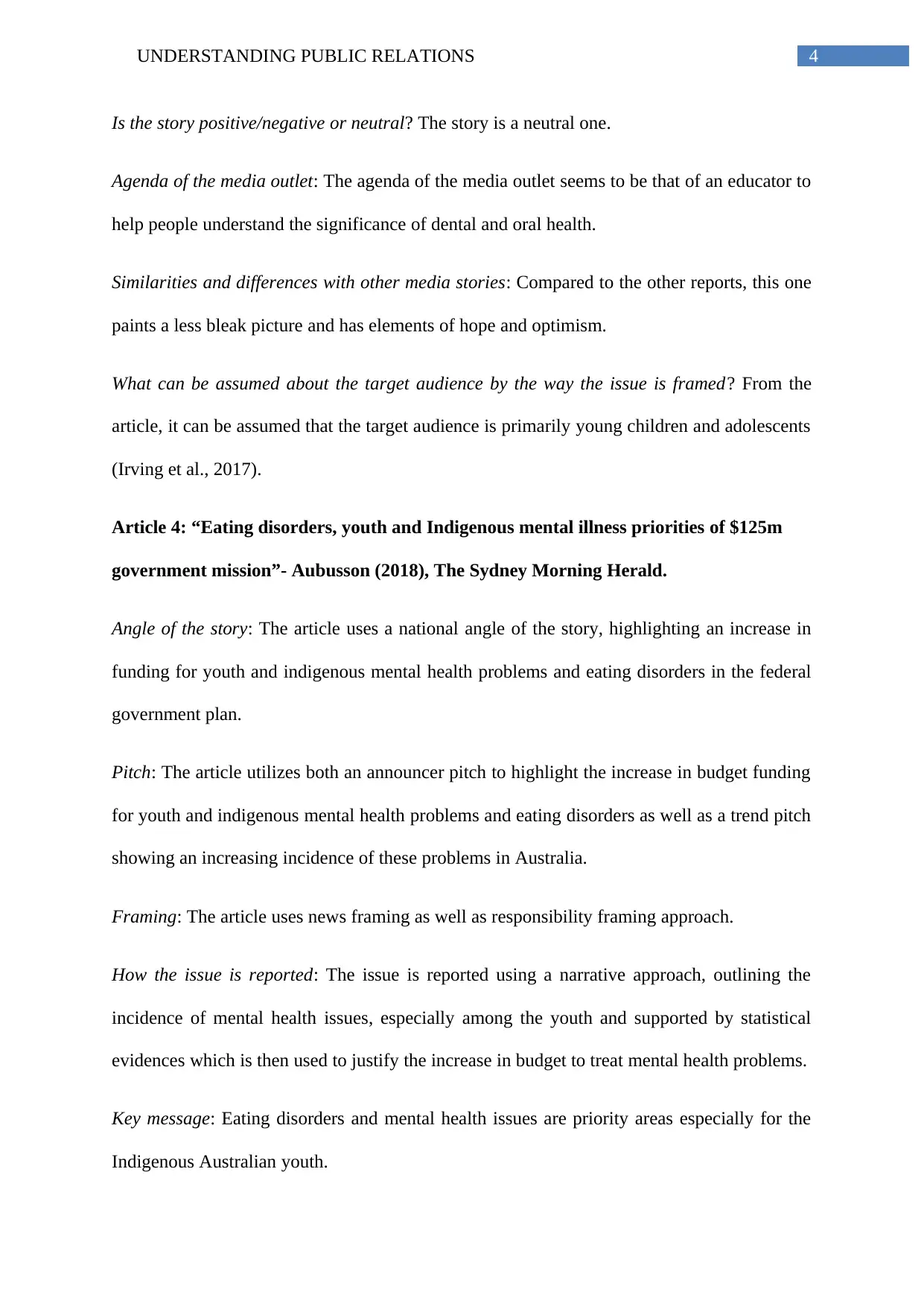
4UNDERSTANDING PUBLIC RELATIONS
Is the story positive/negative or neutral? The story is a neutral one.
Agenda of the media outlet: The agenda of the media outlet seems to be that of an educator to
help people understand the significance of dental and oral health.
Similarities and differences with other media stories: Compared to the other reports, this one
paints a less bleak picture and has elements of hope and optimism.
What can be assumed about the target audience by the way the issue is framed? From the
article, it can be assumed that the target audience is primarily young children and adolescents
(Irving et al., 2017).
Article 4: “Eating disorders, youth and Indigenous mental illness priorities of $125m
government mission”- Aubusson (2018), The Sydney Morning Herald.
Angle of the story: The article uses a national angle of the story, highlighting an increase in
funding for youth and indigenous mental health problems and eating disorders in the federal
government plan.
Pitch: The article utilizes both an announcer pitch to highlight the increase in budget funding
for youth and indigenous mental health problems and eating disorders as well as a trend pitch
showing an increasing incidence of these problems in Australia.
Framing: The article uses news framing as well as responsibility framing approach.
How the issue is reported: The issue is reported using a narrative approach, outlining the
incidence of mental health issues, especially among the youth and supported by statistical
evidences which is then used to justify the increase in budget to treat mental health problems.
Key message: Eating disorders and mental health issues are priority areas especially for the
Indigenous Australian youth.
Is the story positive/negative or neutral? The story is a neutral one.
Agenda of the media outlet: The agenda of the media outlet seems to be that of an educator to
help people understand the significance of dental and oral health.
Similarities and differences with other media stories: Compared to the other reports, this one
paints a less bleak picture and has elements of hope and optimism.
What can be assumed about the target audience by the way the issue is framed? From the
article, it can be assumed that the target audience is primarily young children and adolescents
(Irving et al., 2017).
Article 4: “Eating disorders, youth and Indigenous mental illness priorities of $125m
government mission”- Aubusson (2018), The Sydney Morning Herald.
Angle of the story: The article uses a national angle of the story, highlighting an increase in
funding for youth and indigenous mental health problems and eating disorders in the federal
government plan.
Pitch: The article utilizes both an announcer pitch to highlight the increase in budget funding
for youth and indigenous mental health problems and eating disorders as well as a trend pitch
showing an increasing incidence of these problems in Australia.
Framing: The article uses news framing as well as responsibility framing approach.
How the issue is reported: The issue is reported using a narrative approach, outlining the
incidence of mental health issues, especially among the youth and supported by statistical
evidences which is then used to justify the increase in budget to treat mental health problems.
Key message: Eating disorders and mental health issues are priority areas especially for the
Indigenous Australian youth.
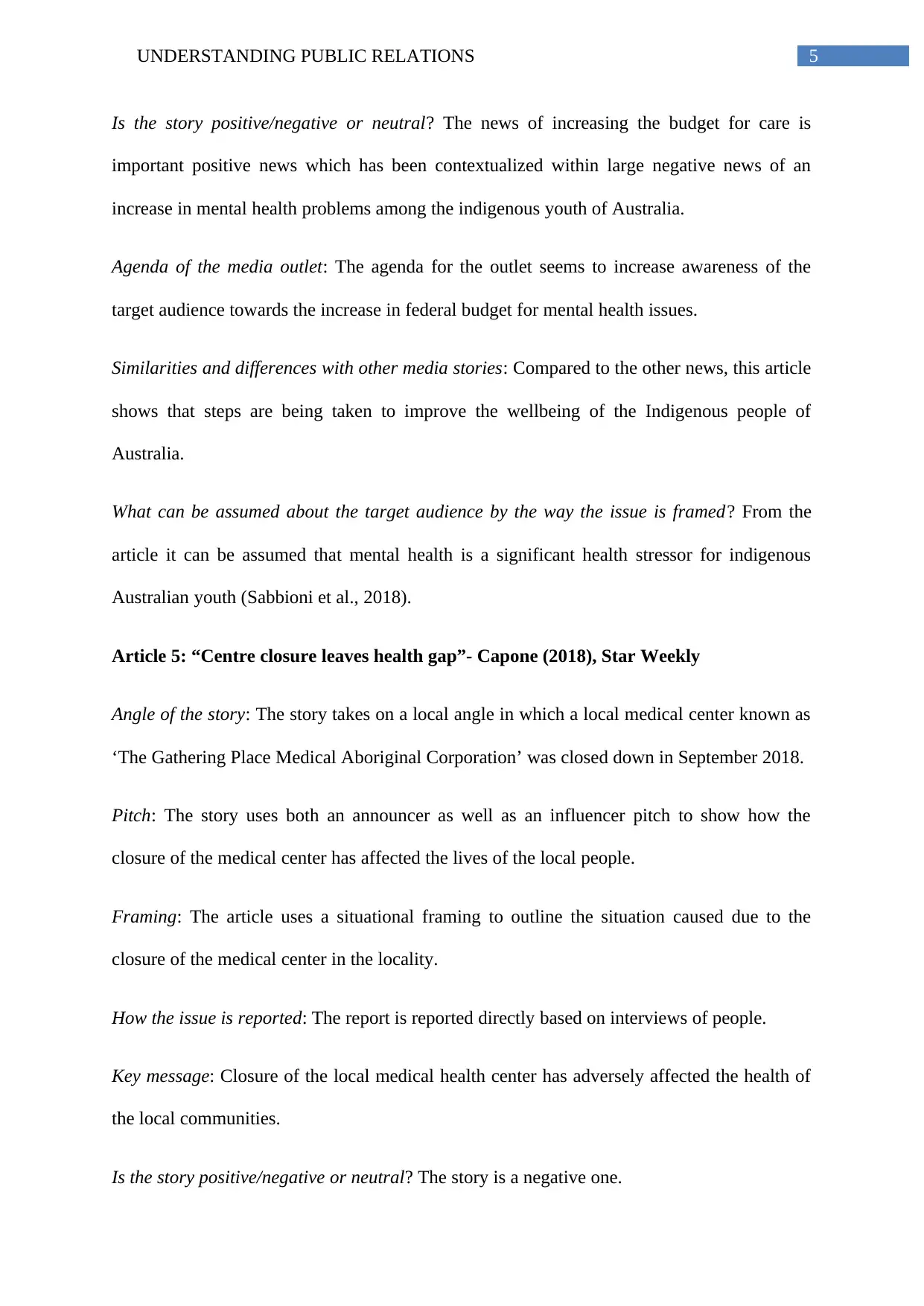
5UNDERSTANDING PUBLIC RELATIONS
Is the story positive/negative or neutral? The news of increasing the budget for care is
important positive news which has been contextualized within large negative news of an
increase in mental health problems among the indigenous youth of Australia.
Agenda of the media outlet: The agenda for the outlet seems to increase awareness of the
target audience towards the increase in federal budget for mental health issues.
Similarities and differences with other media stories: Compared to the other news, this article
shows that steps are being taken to improve the wellbeing of the Indigenous people of
Australia.
What can be assumed about the target audience by the way the issue is framed? From the
article it can be assumed that mental health is a significant health stressor for indigenous
Australian youth (Sabbioni et al., 2018).
Article 5: “Centre closure leaves health gap”- Capone (2018), Star Weekly
Angle of the story: The story takes on a local angle in which a local medical center known as
‘The Gathering Place Medical Aboriginal Corporation’ was closed down in September 2018.
Pitch: The story uses both an announcer as well as an influencer pitch to show how the
closure of the medical center has affected the lives of the local people.
Framing: The article uses a situational framing to outline the situation caused due to the
closure of the medical center in the locality.
How the issue is reported: The report is reported directly based on interviews of people.
Key message: Closure of the local medical health center has adversely affected the health of
the local communities.
Is the story positive/negative or neutral? The story is a negative one.
Is the story positive/negative or neutral? The news of increasing the budget for care is
important positive news which has been contextualized within large negative news of an
increase in mental health problems among the indigenous youth of Australia.
Agenda of the media outlet: The agenda for the outlet seems to increase awareness of the
target audience towards the increase in federal budget for mental health issues.
Similarities and differences with other media stories: Compared to the other news, this article
shows that steps are being taken to improve the wellbeing of the Indigenous people of
Australia.
What can be assumed about the target audience by the way the issue is framed? From the
article it can be assumed that mental health is a significant health stressor for indigenous
Australian youth (Sabbioni et al., 2018).
Article 5: “Centre closure leaves health gap”- Capone (2018), Star Weekly
Angle of the story: The story takes on a local angle in which a local medical center known as
‘The Gathering Place Medical Aboriginal Corporation’ was closed down in September 2018.
Pitch: The story uses both an announcer as well as an influencer pitch to show how the
closure of the medical center has affected the lives of the local people.
Framing: The article uses a situational framing to outline the situation caused due to the
closure of the medical center in the locality.
How the issue is reported: The report is reported directly based on interviews of people.
Key message: Closure of the local medical health center has adversely affected the health of
the local communities.
Is the story positive/negative or neutral? The story is a negative one.
⊘ This is a preview!⊘
Do you want full access?
Subscribe today to unlock all pages.

Trusted by 1+ million students worldwide
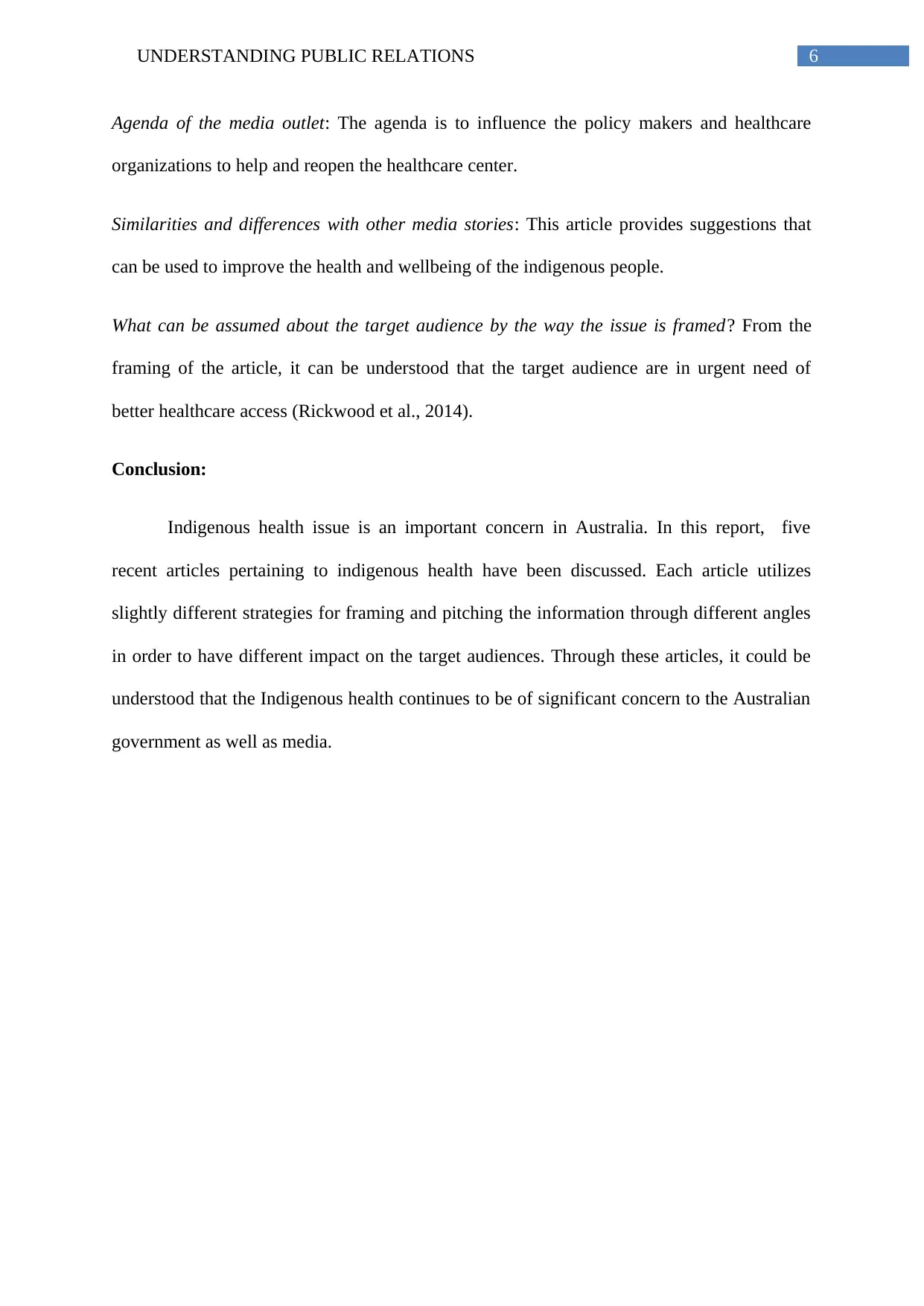
6UNDERSTANDING PUBLIC RELATIONS
Agenda of the media outlet: The agenda is to influence the policy makers and healthcare
organizations to help and reopen the healthcare center.
Similarities and differences with other media stories: This article provides suggestions that
can be used to improve the health and wellbeing of the indigenous people.
What can be assumed about the target audience by the way the issue is framed? From the
framing of the article, it can be understood that the target audience are in urgent need of
better healthcare access (Rickwood et al., 2014).
Conclusion:
Indigenous health issue is an important concern in Australia. In this report, five
recent articles pertaining to indigenous health have been discussed. Each article utilizes
slightly different strategies for framing and pitching the information through different angles
in order to have different impact on the target audiences. Through these articles, it could be
understood that the Indigenous health continues to be of significant concern to the Australian
government as well as media.
Agenda of the media outlet: The agenda is to influence the policy makers and healthcare
organizations to help and reopen the healthcare center.
Similarities and differences with other media stories: This article provides suggestions that
can be used to improve the health and wellbeing of the indigenous people.
What can be assumed about the target audience by the way the issue is framed? From the
framing of the article, it can be understood that the target audience are in urgent need of
better healthcare access (Rickwood et al., 2014).
Conclusion:
Indigenous health issue is an important concern in Australia. In this report, five
recent articles pertaining to indigenous health have been discussed. Each article utilizes
slightly different strategies for framing and pitching the information through different angles
in order to have different impact on the target audiences. Through these articles, it could be
understood that the Indigenous health continues to be of significant concern to the Australian
government as well as media.
Paraphrase This Document
Need a fresh take? Get an instant paraphrase of this document with our AI Paraphraser
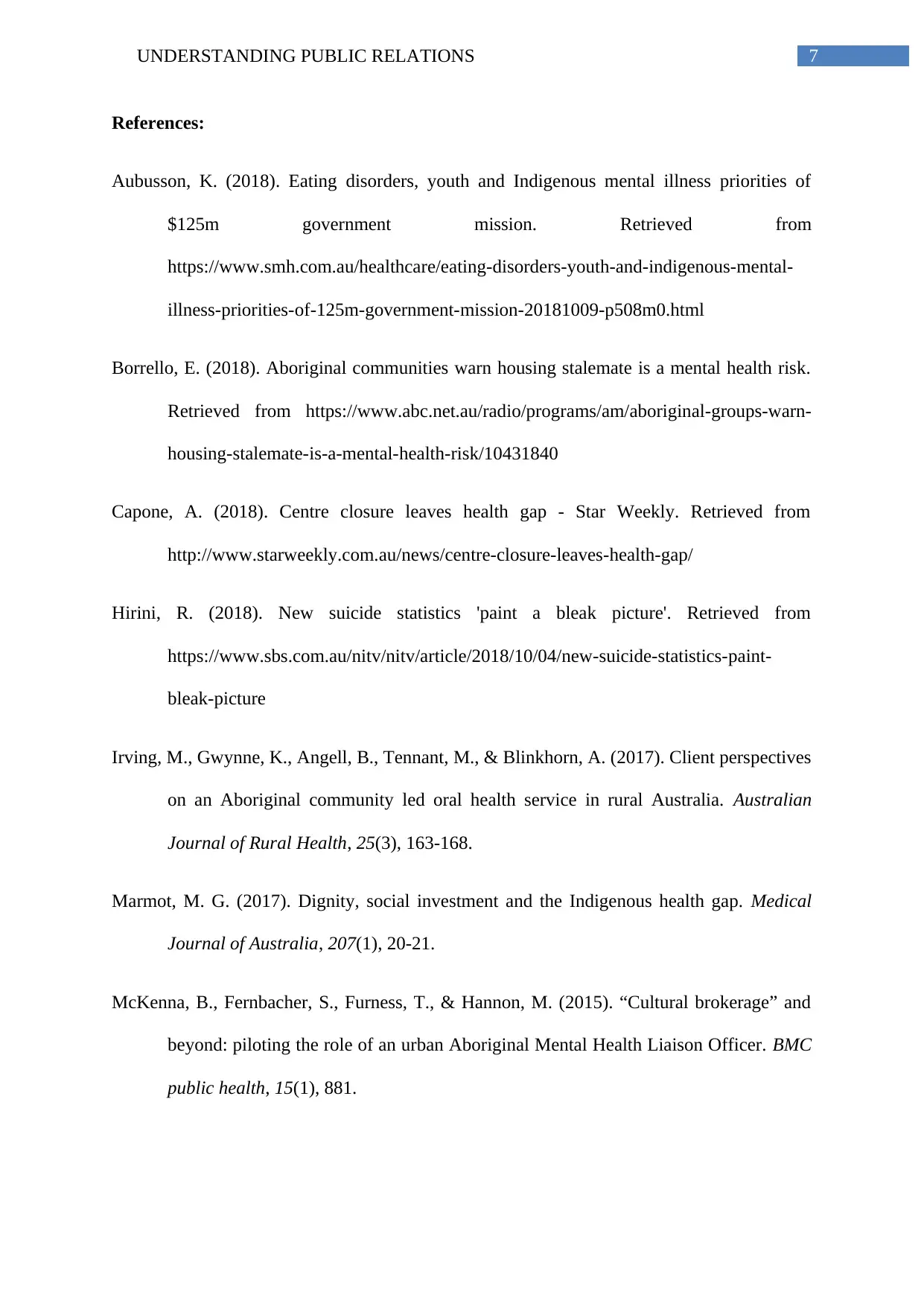
7UNDERSTANDING PUBLIC RELATIONS
References:
Aubusson, K. (2018). Eating disorders, youth and Indigenous mental illness priorities of
$125m government mission. Retrieved from
https://www.smh.com.au/healthcare/eating-disorders-youth-and-indigenous-mental-
illness-priorities-of-125m-government-mission-20181009-p508m0.html
Borrello, E. (2018). Aboriginal communities warn housing stalemate is a mental health risk.
Retrieved from https://www.abc.net.au/radio/programs/am/aboriginal-groups-warn-
housing-stalemate-is-a-mental-health-risk/10431840
Capone, A. (2018). Centre closure leaves health gap - Star Weekly. Retrieved from
http://www.starweekly.com.au/news/centre-closure-leaves-health-gap/
Hirini, R. (2018). New suicide statistics 'paint a bleak picture'. Retrieved from
https://www.sbs.com.au/nitv/nitv/article/2018/10/04/new-suicide-statistics-paint-
bleak-picture
Irving, M., Gwynne, K., Angell, B., Tennant, M., & Blinkhorn, A. (2017). Client perspectives
on an Aboriginal community led oral health service in rural Australia. Australian
Journal of Rural Health, 25(3), 163-168.
Marmot, M. G. (2017). Dignity, social investment and the Indigenous health gap. Medical
Journal of Australia, 207(1), 20-21.
McKenna, B., Fernbacher, S., Furness, T., & Hannon, M. (2015). “Cultural brokerage” and
beyond: piloting the role of an urban Aboriginal Mental Health Liaison Officer. BMC
public health, 15(1), 881.
References:
Aubusson, K. (2018). Eating disorders, youth and Indigenous mental illness priorities of
$125m government mission. Retrieved from
https://www.smh.com.au/healthcare/eating-disorders-youth-and-indigenous-mental-
illness-priorities-of-125m-government-mission-20181009-p508m0.html
Borrello, E. (2018). Aboriginal communities warn housing stalemate is a mental health risk.
Retrieved from https://www.abc.net.au/radio/programs/am/aboriginal-groups-warn-
housing-stalemate-is-a-mental-health-risk/10431840
Capone, A. (2018). Centre closure leaves health gap - Star Weekly. Retrieved from
http://www.starweekly.com.au/news/centre-closure-leaves-health-gap/
Hirini, R. (2018). New suicide statistics 'paint a bleak picture'. Retrieved from
https://www.sbs.com.au/nitv/nitv/article/2018/10/04/new-suicide-statistics-paint-
bleak-picture
Irving, M., Gwynne, K., Angell, B., Tennant, M., & Blinkhorn, A. (2017). Client perspectives
on an Aboriginal community led oral health service in rural Australia. Australian
Journal of Rural Health, 25(3), 163-168.
Marmot, M. G. (2017). Dignity, social investment and the Indigenous health gap. Medical
Journal of Australia, 207(1), 20-21.
McKenna, B., Fernbacher, S., Furness, T., & Hannon, M. (2015). “Cultural brokerage” and
beyond: piloting the role of an urban Aboriginal Mental Health Liaison Officer. BMC
public health, 15(1), 881.
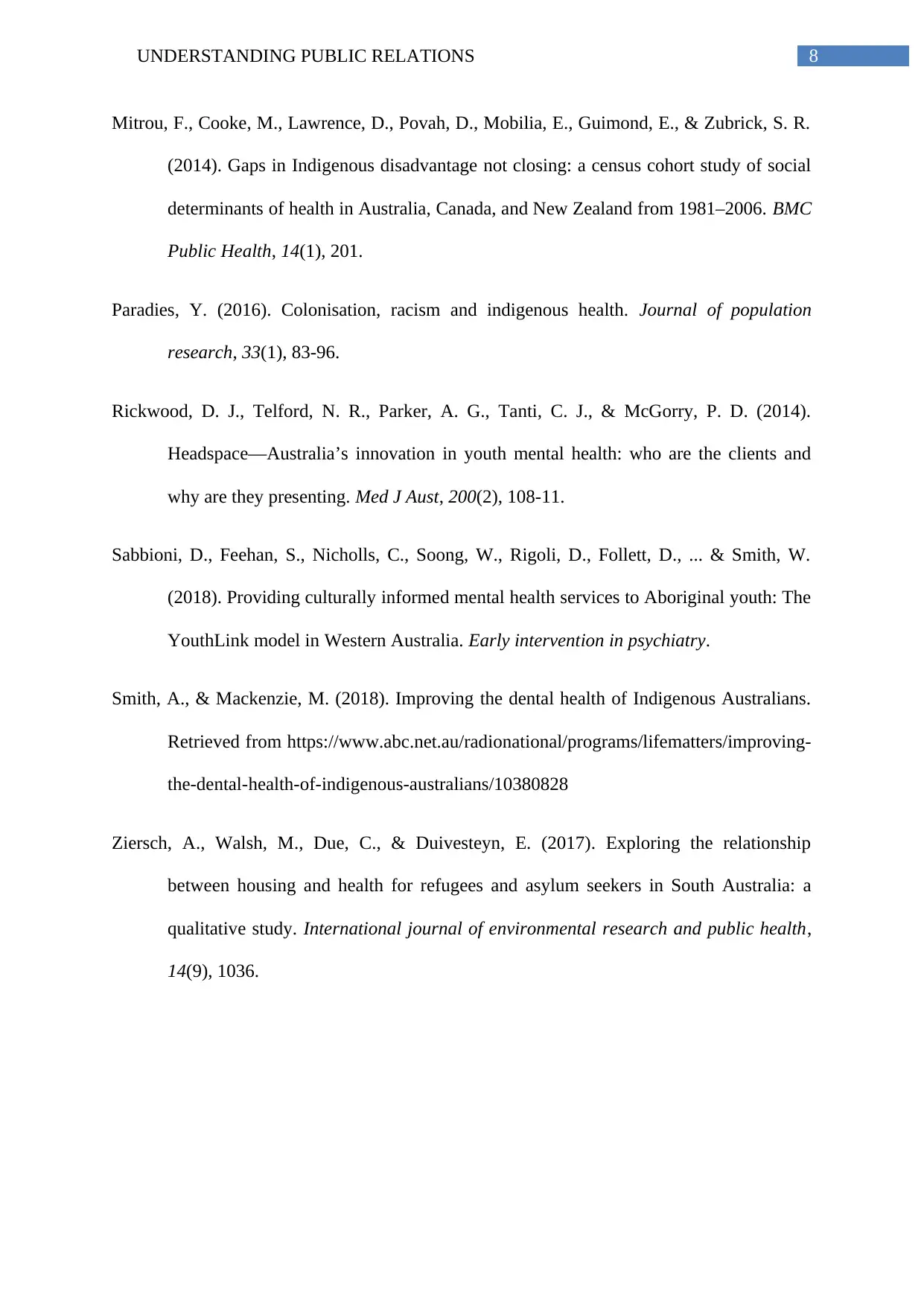
8UNDERSTANDING PUBLIC RELATIONS
Mitrou, F., Cooke, M., Lawrence, D., Povah, D., Mobilia, E., Guimond, E., & Zubrick, S. R.
(2014). Gaps in Indigenous disadvantage not closing: a census cohort study of social
determinants of health in Australia, Canada, and New Zealand from 1981–2006. BMC
Public Health, 14(1), 201.
Paradies, Y. (2016). Colonisation, racism and indigenous health. Journal of population
research, 33(1), 83-96.
Rickwood, D. J., Telford, N. R., Parker, A. G., Tanti, C. J., & McGorry, P. D. (2014).
Headspace—Australia’s innovation in youth mental health: who are the clients and
why are they presenting. Med J Aust, 200(2), 108-11.
Sabbioni, D., Feehan, S., Nicholls, C., Soong, W., Rigoli, D., Follett, D., ... & Smith, W.
(2018). Providing culturally informed mental health services to Aboriginal youth: The
YouthLink model in Western Australia. Early intervention in psychiatry.
Smith, A., & Mackenzie, M. (2018). Improving the dental health of Indigenous Australians.
Retrieved from https://www.abc.net.au/radionational/programs/lifematters/improving-
the-dental-health-of-indigenous-australians/10380828
Ziersch, A., Walsh, M., Due, C., & Duivesteyn, E. (2017). Exploring the relationship
between housing and health for refugees and asylum seekers in South Australia: a
qualitative study. International journal of environmental research and public health,
14(9), 1036.
Mitrou, F., Cooke, M., Lawrence, D., Povah, D., Mobilia, E., Guimond, E., & Zubrick, S. R.
(2014). Gaps in Indigenous disadvantage not closing: a census cohort study of social
determinants of health in Australia, Canada, and New Zealand from 1981–2006. BMC
Public Health, 14(1), 201.
Paradies, Y. (2016). Colonisation, racism and indigenous health. Journal of population
research, 33(1), 83-96.
Rickwood, D. J., Telford, N. R., Parker, A. G., Tanti, C. J., & McGorry, P. D. (2014).
Headspace—Australia’s innovation in youth mental health: who are the clients and
why are they presenting. Med J Aust, 200(2), 108-11.
Sabbioni, D., Feehan, S., Nicholls, C., Soong, W., Rigoli, D., Follett, D., ... & Smith, W.
(2018). Providing culturally informed mental health services to Aboriginal youth: The
YouthLink model in Western Australia. Early intervention in psychiatry.
Smith, A., & Mackenzie, M. (2018). Improving the dental health of Indigenous Australians.
Retrieved from https://www.abc.net.au/radionational/programs/lifematters/improving-
the-dental-health-of-indigenous-australians/10380828
Ziersch, A., Walsh, M., Due, C., & Duivesteyn, E. (2017). Exploring the relationship
between housing and health for refugees and asylum seekers in South Australia: a
qualitative study. International journal of environmental research and public health,
14(9), 1036.
⊘ This is a preview!⊘
Do you want full access?
Subscribe today to unlock all pages.

Trusted by 1+ million students worldwide
1 out of 9
Related Documents
Your All-in-One AI-Powered Toolkit for Academic Success.
+13062052269
info@desklib.com
Available 24*7 on WhatsApp / Email
![[object Object]](/_next/static/media/star-bottom.7253800d.svg)
Unlock your academic potential
Copyright © 2020–2025 A2Z Services. All Rights Reserved. Developed and managed by ZUCOL.




